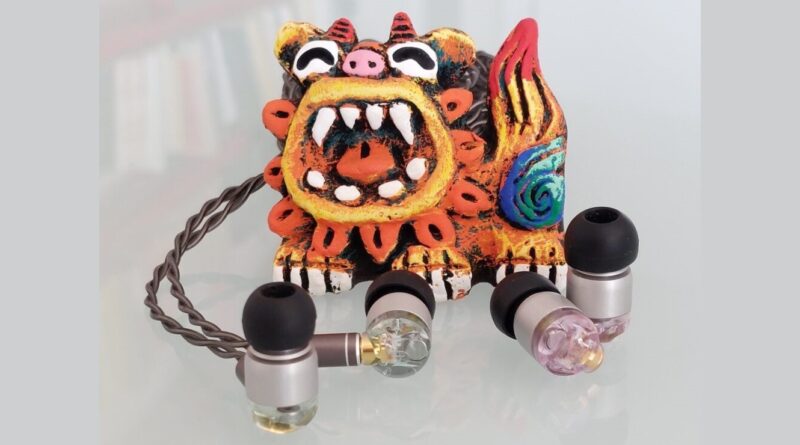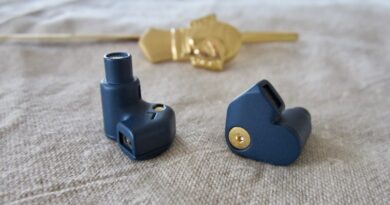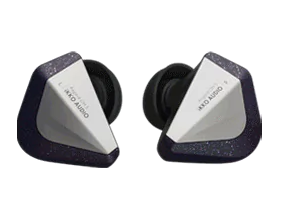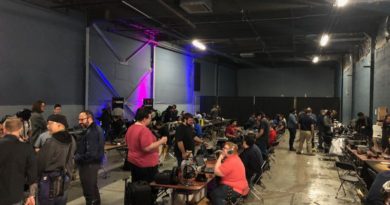Intime Sho DD Review (Two Different Ones)
O2aid Inc – the Japan-based company behind the commercial brand “Intime Acoustics” – is a very small business with a strongly artisanal trait. Their flagship IEM model called Sho (翔) is exclusively handmade-to-order, for example. Then, they have another model called Sho (翔) DD, this time serial-made, which is marketed as an affordable hint to the flagship’s sound.
Sho DD differ from Sho at various levels, including the housing material (an AL-CU alloy in lieu of Titanium), the material chosen for the ceramic tweeter, the sophystication of the pentaconn connectors, etc, so I’m sure it’d be wrong to expect that Sho DD represent a “Sho replacement” at a much lower price, as it would after all be totally illogical on a commercial level of course.
I happen to have two different versions of Sho DD available: the standard one, regularly in production and purchaseable from the company’s website (here without a cable for the equivalent of less than 100€, or here with a cable, for the equivalent of less than 200€), and a special edition called Sho DD Halloween, externally recogniseable by their purple colored backside resin, currently out of production. One of the two is my own property, the other has been sent to me courtesy of the manufacturer.
The description here below refers to the currently shipping Sho DD version. I’ll add the differential notes regarding Sho DD Halloween in the Comparison section below.
In this Article
At-a-glance Card
| PROs | CONs |
| Greatly executed V-shape tuning | It’s a V-shape. Pass if you looking for a vocals-focused driver (et al). |
| Energetic, engaging, dynamically calibated tonality | Fat bullet shape might be not everyone’s love |
| Very good lushy, controlled bass | May require careful eartips selection |
| Unique, market-leading high-mids and treble timbre and quality | No direct EU distribution yet (but reforwarding works well) |
| Spectacular layering and separation | |
| Very good stage drawing and imaging | |
| Decently easy to drive | |
| Ridiculously affordable |
Full Device Card
Test setup and preliminary notes
Sources: Sony NW-A55 mrWalkman / Questyle QP1R, QP2R, M15, CMA-400i / Dragonfly Cobalt – JVC Spiraldot silicon tips – Dunu DUW-02S cable – lossless 16-24/44.1-192 FLAC and DSD64/128/256 tracks.
I am not writing these articles to help manufacturers promote their products, even less I’m expecting or even accepting compensation when I do. I’m writing exclusively to share my fun – and sometimes my disappointment – about gear that I happen to buy, borrow or somehow receive for audition.
Another crucial fact to note is that I have very sided and circumscribed musical tastes: I almost exclusively listen to jazz, and even more particularly to the strains of post bop, modal, hard bop and avantgarde which developed from the late ’50ies to the late ’70ies. In audio-related terms this implies that I mostly listen to musical situations featuring small or even very small groups playing acoustic instruments, on not big stages.
One of the first direct consequences of the above is that you should not expect me to provide broad information about how a certain product fairs with many different musical genres. Oppositely, you should always keep in mind that – different gear treating digital and analog sound in different ways – my evaluations may not, in full or in part, be applicable to your preferred music genre.
Another consequece is that I build my digital library by painstakingly cherrypick editions offering the least possible compression and pumped loudness, and the most extended dynamic range. This alone, by the way, makes common music streaming services pretty much useless for me, as they offer almost exclusively the polar opposite. And again by the way, quite a few of the editions in my library are monoaural.
Additionally: my library includes a significant number of unedited, very high sample rate redigitisations of vinyl or openreel tape editions, either dating back to the original day or more recently reissued under specialised labels e.g. Blue Note Tone Poet, Music Matters, Esoteric Jp, Analogue Productions, Impulse! Originals, and such. Oppositely, I could ever find and extremely small number of audible (for my preferences) SACD editions.
My source gear is correspondigly selected to grant very extended bandwidth, high reconstruction proweness, uncolored amping.
And finally, my preferred drivers (ear or headphones) are first and foremost supposed to feature solid note-body timbre, and an as magically centered compromise between fine detail, articulated texturing and microdynamics as their designers can possibly achieve.
In terms of presentation, for IEMs I prefer one in the shape of a DF curve, with some very moderate extra pushup in the midbass. Extra sub-bass enhancement is totally optional, and solely welcome if seriously well controlled. Last octave treble is also welcome from whomever is really able to turn that into further spatial drawing upgrade, all others please abstain.
Signature analysis
Tonality
Sho DD presentation is a sort of V-shape, with vivid yet controlled high-mids. Their tonality is on the warm side of neutral, however much less than the muscular bass might threaten to make it at first hearing.
The timbre… that’s where it gets tricky. On Sho DD timbre depends quite heavily on how trebles come up, which in turn changes even dramatically depending on eartips selection and insertion depth.
More in detail: when “casually” worn, and with narrow bore tips, Sho DD may easily present a dual-timbre scenario with a solid, bodied, muscular bass standing in front of razor cutting, brilliant, finely detailed treble (and highmids, to some extent). Such “inconsistency” might even rather be taken as a “duality”, something in the ballpark of a 2 tweeters + 1 subwoofer nearfield setup, to give an idea of what I’m talking about.
By working on insertion position and eartips (wider bore) it’s however very possible to smoothen the highs a bit, taming their finest and leanest fringes, but most of all adding to their body thereby significantly closing the gap with bass notes. That’s where my recommendation rootens, to choose for JVC Spiraldots.
Even with that Sho DD will be living on a dynamic balance between diverse elements, much different from a seemless or near-seemless merge like you can get on other hybrid setups. Such situation is very thin ice to thread onto: when done right a good orchestration delivers extremely interesting composite results, and comes across nearly unhearable otherwise. Sho DD are an evident example of the former case.
Last but not least: of course tips choice and insertion positioning being totally subjective, it may well be the case that the virtuous scenario I just mentioned takes place in your case just on stock tips, or with totally different ones. You’ll have to try your own mileage.
Sub-Bass
Sho DD have a hefty, solid, physical sub-bass acting like a concrete basement, while staying separated from the rest for most if not at all times.
Mid Bass
Midbass is no doubt one of Sho DD’s strengths. It’s thick, visceral yet very well controlled, quite fast but not sharp and very well textured. Transients are calibrated on a totally commendable speed compromise point, to one of the best “thick-bass tunings” I ever came across.
Mids
Mids are obviously positionally recessed nonetheless they carry good definition. Their note body is also not lean, just “unlushy” in a sense, such as to make vocals, guitars and part of the piano stay more in the back in relation to drums, winds and drumplates which are made to take the lead by Sho DD.
I guess it’s fair to say of Sho DD that they represent an example of a situation where leaving some parts (like mids and vocals) on second-priority does not necessarily mean not curing them at all. Au contraire.
Male Vocals
As they are contributed to both by the VST and DD driver, male vocals are indeed more than pleasing on Sho DD. Certainly positioned in the back, they carry good texture and especially more than decent organicity and credibility.
Female Vocals
Taken in absolute terms female vocals are also relatively un-lushy and somewhat cold, yet can’t call them lean: they indeed carry more than a bit of texture. If I put them in a V shape sig perspective they are actually very good for the category.
Highs
If I had to elect my preferred value on all Intime IEMs I heard (a total of 8 different models till now) their unique highmids and treble rendering is very likely where my choice would land. Which is in the end consistent with the fact that their patented ceramic-based piezo tweeter is the owner’s competence specialty coming from his previous professional history, too.
Be as it may, Sho DD’s highs section is shiny, vivid, energetic and fundamentally always south of excessive.
Also, if after trying other piezo technology drivers you tend to expect a characteristic unwanted timbre to them well, forget it: Intime’s VST does not carry any “electric” sheen or aftertaste.
Technicalities
Soundstage
Sho DD offer a very sizeable horizontal stage, good height and above average depth.
Imaging
Macrodynamics are extremely good, mainly thanks to the solid but unbloating bass not covering the tweeter’s job. Mid’s recession may occasionally put some vocals or guitars a bit too much in the background.
Details
The combined effort of the two drivers grants very good detail retrieval from all segments of the spectrum. The lion’s part is surely taken by treble, especially in their higher part, which deliver
Instrument separation
Sho DD are extremely good at separation and layering, and that’s surprising after the first audition when you notice those lushy midbass and their buttery transients. The crux is that bass stays so well controlled, and the VST2 driver extends all the way down to the mids, the result being just gorgeous with the user being able to follow each voice singularly, even on crowded passages.
Curiously enough, bass comes across physically “above” (in the sense of soundstage’s vertical dimension) mid tones most of the times, unlike what I tend to here more often on other IEMs.
Driveability
Sho DD require “some” amping power due to their somewhat modest sensitivity (100dB/mW). The good news is their impedance is not ultra-low (22 ohm), which increases the population of sources able to deliver the required current at that load point.
Physicals
Build
Much like most of Intime’s other models, Sho DD’s housings are made of two parts: a Duralumin front, complemented by a resin back side. “DD” in the name stands in fact for “Duralumin Design”, and also somehow recalls the presence of a DD (Dynamic Driver) inside.
Fit
Bullet shapes (slim ones like those designed by Final or Akoustyx, or fat ones like Intime’s) are quite easy to fit for me, just a bit wobbly.
I always considered wobblyness as a sort of unavoidable drawback until I came across those Earlock fitters bundled with Akoustyx S6, which taught me that it is possible to stabilse bullet-shaped housings, and do that for good. Sadly, original Earlocks won’t fit Sho-DD due to their too small central bore, so I temporarly adopted “comma-shaped” rubber fitters. The result is better than nothing but not perfect yet, so I’m keeping my search for suitable Earlock-shaped alternatives – stay tuned… 😉
Eartip selection is one of those particularly tricky cases here. Most of the silicones I tried make treble going too hot and somewhat metallic. At long last I concluded that the best 3 silicon options are Acoustune ET07 (that is – guess what – those bundled with the product), Intime’s own iSep01 tips, or JVC SpiralDots.
Nearly identical to ET07 in shape and size, Intime’s own iSep are not ideal for my particular case however due to their softer umbrella structure: that’s supposed to be more comfortable to wear, and bring the advantage of a somewhat tighter bass, but it also proves a bit “too soft” for my particular case, and it tends to collapse under my ear canal tightening, thereby losing the seal – which does not happen with their stiffer siblings, the original ET07.
SpiralDots are an even better bet in terms of treble rendering, but they come with a further note body incresase on the midbass, which some might find excessive, even if it’s not associated with any additional transient loosening / bloating.
A very good alternative to silicones are foamies, which I normally don’t like but in this particular case I got very good sonic results with Comply TSX-400, and with INAIR Air-2, both of which I can then dearly recommend.
Comfort
Very subjective. I personally find them quite comfortable like all bullet shaped housings, even better if complemented with suitable rubber fitters (see above).
Isolation
No concha shielding due to bullet shape, but their “fat” build contributes positively nonetheless.
Cable
Sho DD are offered in 3 alternative packages: just the housings with MMCX connectors and no cable, the housings with MMCX connectors and a silver plated OFC 3.5mm terminated cable (“Intime M drum” cable), and the housings with proprietary Intime Pentaconn connectors and the matching silver plated OFC cable, in a choice of 3.5, 2.5 or 4.4 termination (“Intime P Tsuzumi” cable).
While Intime’s silver plated OFC cable is technically good, Sho DD (like Miyabi) are very sensitive to cable variations and after quite a few swaps and rotations I found Dunu DUW-02S pair best on Sho DD, significantly improving layering, separation and airness.
Specifications (declared)
| Housing | Hard duralumin + resin |
| Driver(s) | Hybrid type 10mm dynamic speaker + 3rd generation VST2 with HDSS® |
| Connector | MMCX |
| Cable | Intime M-Drum silver plated OFC 1.2m cable with 3.5mm single ended termination |
| Sensitivity | 100 dB/mW |
| Impedance | 22 Ω |
| Frequency Range | 10-45000Hz |
| Package and accessories | 1 set of 4 pairs (S, M-, M, L) Acoustune ET07 eartips, cloth pouch |
| MSRP at this post time | JPY 13800 without cable, JPY 27500 with cable |
Key technologies
I already covered Intime’s key internal technologies within my previous articles regarding Intime IEMs, here and here. I’ll quickly go through the differences applying to Sho DD.
The Dynamic Driver has a Titanium coating, different from Miyabi and Sora 2 which carry a Graphene-coated membrane.
The housing’s front part is made of Duralumin, which is an alloy made of Aluminun, Copper and some other stuff. Its advantages are basically similar resistance as stainless steel, with a weight similar to aluminum instead.
The VST tweeter and the HDSS device are instead both 3rd generation version, the same adopted inside Miyabi.
Comparisons
Intime Sho DD Halloween (discontinued)
Externally different just insofar as they carry a purple-colored resin housing backside (vs. regular Sho DD’s clear/transparent one) internally they reportedly differ only for a slighty different internal wiring.
Sonically, Sho DD Halloween come with a bit dampened, “more polite” (“less energetic”) highmids and treble. Sho DD are “crisper” up there. Sho DD Halloween alre also somewhat slammier on the midbass, decay is a bit shorter. I think the mids being a bit more evident compared to Sho DD are a consequence of what precedes.
final E5000 (€ 249)
Given E5000’s strong oddity, this comparison can’t forget to mention powering requirements.
When both are paired to a high(er) system, featuring very strong current delivery on low impedance loads, e.g. CMA-400i, QP1R/QP2R, 9038SG3 etc, then Sho DD deliver more solid note body and slightly less controlled midbass compared to E5000. Mids and vocals are less recessed on E5000, which also makes them sound a bit more organic. Sho DD delivers all the highmids and treble power, air, and energy that E5000 lacks. And finally, E5000 is still a bit (yet not much) better at layering compared to Sho DD.
When instead both are paired to a weaker-current source (e.g Dragonfly Cobalt, Sony A55, etc etc) E5000’s bass overfills the place and the presentations stirs towards darker tones – while Sho DD suffers much less if at all of the situation, coming out simply better on all respects in that situation.
Ikko OH10 (€ 170)
OH10’s bass is way tighter, colder and slammier, therefore less visceral and textured. Sub bass is a bit deeper on OH10, most of all more hearable due to the leaner midbass. Mids are similarly recessed but Sho DD has a fatter note body and therefore a more organic timbre. Treble air is similar, Sho DD is more energetic and presence treble is superior in quantity and quality. On the flip side OH10 is (in comparison) more relaxing in a sense.
Considerations & conclusions
Really well exectured V-shape IEMs are very uncommon, and that’s an already good reason to recommend Sho DD to those looking for one.
Add near-perfectly harmonised heterogenous drivers offering meaty yet controlled bass, and sparkly, vivid, energetic, highmids and trebles free from excesses and sheens. Complete with spectactular technicalities and you’re close to unicity. Masterful, nothing short of it.
Our generic standard disclaimer.








Hey there Alberto! Well, i just compiled what i hope is a comprehensive list of Intime product, very impressive for a v small company, but also daunting for anyone not permanently resident in a big Japanese city. Last time i was there it tool all my audition time at e-earphone just to get through the Radiuses! – Radii? )
Todoroki
Kira
Kotteri (Mk 1 / 2 )
Sakai
Hibiki-Kyo
GO
YO
SHO (ShoDD, Sho4.4 ShoSpecialVersion)
Electro
Aoi (Mk 1 /2 )
Shachi
Sora ( Mk 1 / 2 / Light /Unique Bass)
Miyabi ( Mk 1 / 2 )
Ti3 ( Ti3 Edition 2)
Thus far i have but the original Sora and Miyabi Mk 1. Listening to the latter and reading you has me wanting for more. For now i’ve decided on the Unique Bass and the Aoi 2 (Miyabi’s wonders are compromised for me somewhat by their extremely ‘controlled’ bass, so UB was obvious choice) As for Aoi, hell, i have to start somewhere! Now according to Spotify i listen to “80 different genres”, excluding as it happens your very own declared focus ‘acoustic jazz’. Might you indicate which of this crazy product line – almost all of which have stupidly similar appearance – might offer the least brilliant, glaresome treble? Where mids are full and the bottom end reaches way down with plenteous ‘rondeur’? Tell me it isn’t the expensive ones!